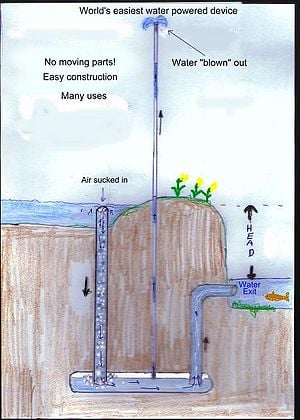(tidy, suggested project) |
|||
| Line 1: | Line 1: | ||
[[Image:Dra.JPG|thumb|left| this shows a pulser pump]] | [[Image:Dra.JPG|thumb|left| this shows a pulser pump]] | ||
<br clear="all" /> | <br clear="all" /> | ||
==Introduction== | ==Introduction== | ||
The pulser pump is the world's simplest pump. It is a water powered device. It is NOT a ram pump. It IS a combination of a trompe and an air lift pump. Trompes were used before hydroelectric turbines to pump air into mines, to provide air for the pneumatic machines that made some of the first alpine tunnels and to provide air to drive motors that lit the wealthy parts of paris in the late 19th century. Air lift pumps are still widely used by water utilitys to pump water from very deep wells. They use compressers to push air down into the wells and the air erupts through another wider pipe carying water with it. | The pulser pump is the world's simplest pump. It is a water powered device. It is NOT a ram pump. It IS a combination of a trompe and an air lift pump. Trompes were used before hydroelectric turbines to pump air into mines, to provide air for the pneumatic machines that made some of the first alpine tunnels and to provide air to drive motors that lit the wealthy parts of paris in the late 19th century. Air lift pumps are still widely used by water utilitys to pump water from very deep wells. They use compressers to push air down into the wells and the air erupts through another wider pipe carying water with it. | ||
The pulser pump simply uses the trompe part to power the airlift part. A pulser pump is just pipes joined together with no moving parts and I think it should be ideal for many waterside communitys for pumping and other uses. A video explaining the pump can be | |||
The pulser pump simply uses the trompe part to power the airlift part. A pulser pump is just pipes joined together with no moving parts and I think it should be ideal for many waterside communitys for pumping and other uses. A video explaining the pump can be seen [http://ca.youtube.com/watch?v=QOn7Zu3CCxo here]. | |||
A video of a 20 year old (and still working) pulser pump can be seen [http://ca.youtube.com/watch?v=oxJTC77PADQ Here] This pump is powered by a little stream with 300 liters of water falling 0.5 meters producing the power. Pulser pumps can work with much larger flows and heads than that but I did not have such a site. | A video of a 20 year old (and still working) pulser pump can be seen [http://ca.youtube.com/watch?v=oxJTC77PADQ Here] This pump is powered by a little stream with 300 liters of water falling 0.5 meters producing the power. Pulser pumps can work with much larger flows and heads than that but I did not have such a site. | ||
Pulser pumps lack credibility because there has been no peer review.{{sp}} Until someone other than me ([[User:Gaiatechnician|Gaiatechnician]] makes one or makes models of them, this will continue to be the case. | |||
Because of their extreme simplicity, they can be of great value to impoverished waterside communitys. | |||
The tiny pulser pump in the video can pump about 5 tonnes of water per day to a shed. Imagine the alternative? Dragging the water in buckets! | |||
[[CATEGORY: Pumps]] | |||
[[CATEGORY: | |||
Revision as of 01:43, 6 February 2008

Introduction
The pulser pump is the world's simplest pump. It is a water powered device. It is NOT a ram pump. It IS a combination of a trompe and an air lift pump. Trompes were used before hydroelectric turbines to pump air into mines, to provide air for the pneumatic machines that made some of the first alpine tunnels and to provide air to drive motors that lit the wealthy parts of paris in the late 19th century. Air lift pumps are still widely used by water utilitys to pump water from very deep wells. They use compressers to push air down into the wells and the air erupts through another wider pipe carying water with it.
The pulser pump simply uses the trompe part to power the airlift part. A pulser pump is just pipes joined together with no moving parts and I think it should be ideal for many waterside communitys for pumping and other uses. A video explaining the pump can be seen here. A video of a 20 year old (and still working) pulser pump can be seen Here This pump is powered by a little stream with 300 liters of water falling 0.5 meters producing the power. Pulser pumps can work with much larger flows and heads than that but I did not have such a site.
Pulser pumps lack credibility because there has been no peer review.[expansion needed] Until someone other than me (Gaiatechnician makes one or makes models of them, this will continue to be the case.
Because of their extreme simplicity, they can be of great value to impoverished waterside communitys. The tiny pulser pump in the video can pump about 5 tonnes of water per day to a shed. Imagine the alternative? Dragging the water in buckets!